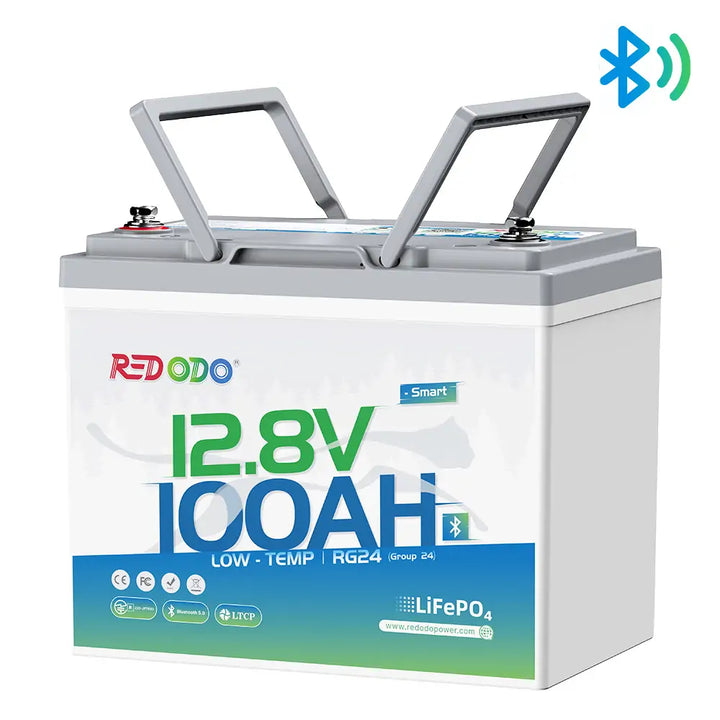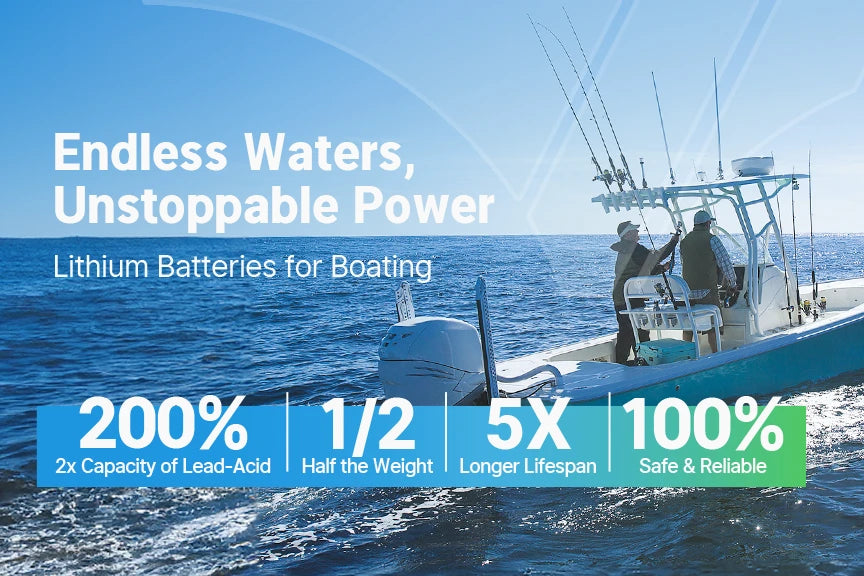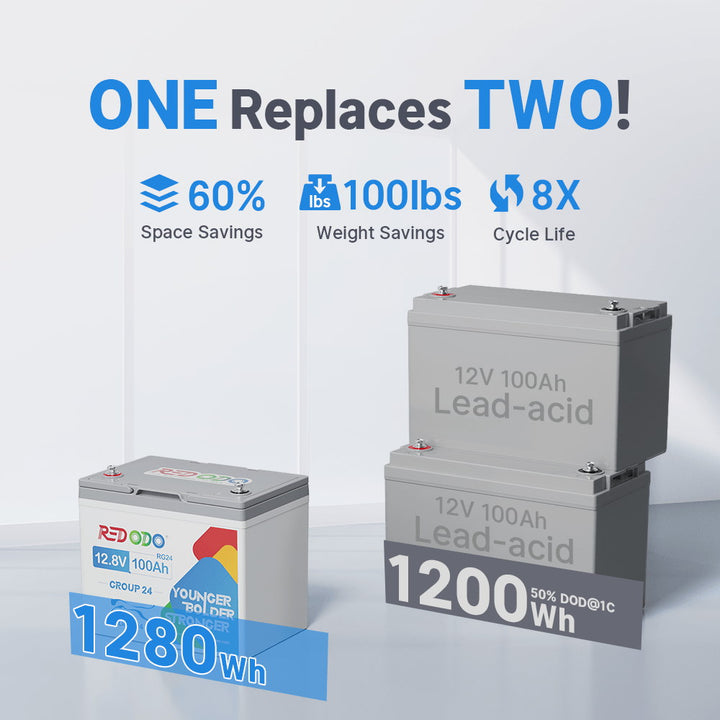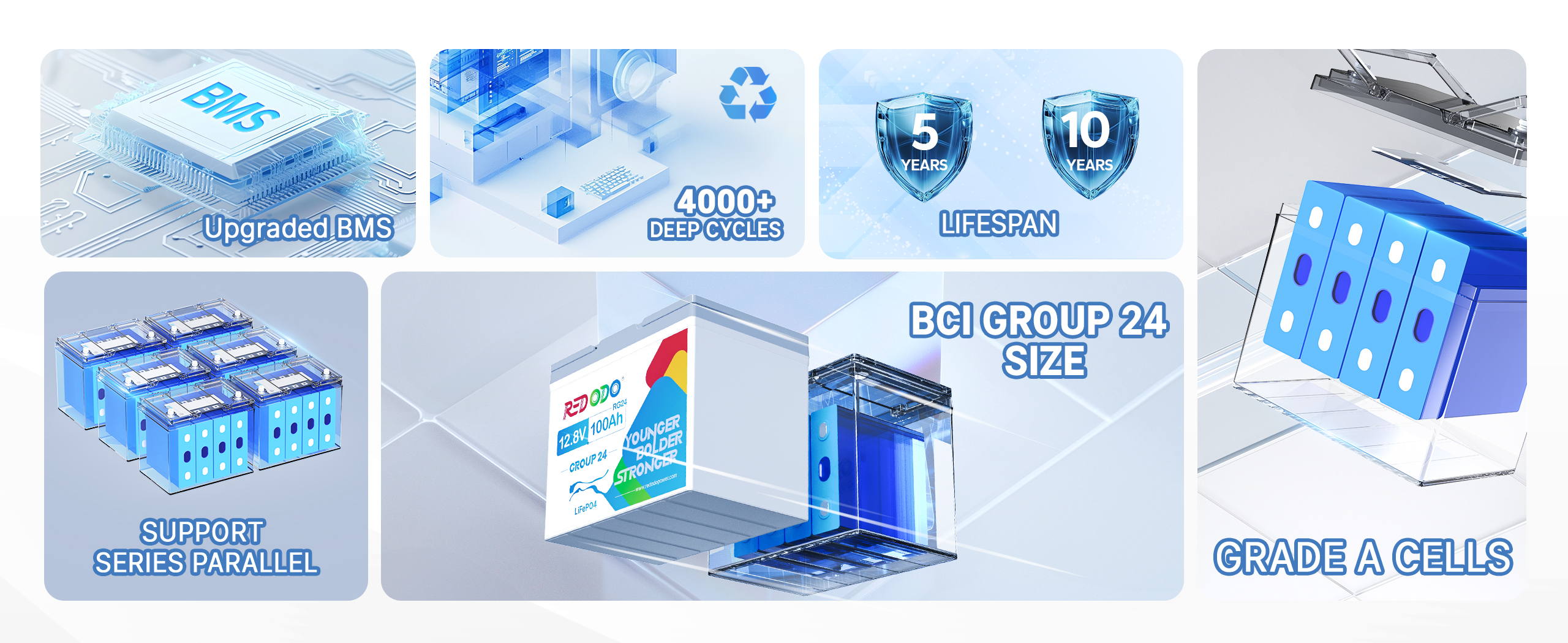When choosing a marine battery, size, capacity, and application are key factors. Group 24 and Group 27 batteries are both widely used in boats, trolling motors, and marine applications. But which one should you pick?
This article will compare Group 24 and Group 27 marine batteries in terms of size, capacity, chemistry, weight, price, and applications, helping you make an informed decision.
Table of Content
Key Differences Between Group 24 and Group 27 Marine Batteries
1. Size and Dimensions
The main difference between Group 24 and Group 27 batteries is their size. Battery group sizes are standardized by the Battery Council International (BCI), which defines the physical dimensions, terminal positions, and general application guidelines for different battery types.
- Group 24 battery dimensions are more compact and lightweight, typically measuring 10.25 x 6.81 x 8.88 inches. They are a popular choice for RVs, smaller boats and auxiliary power needs, where space and weight are key considerations.
- Group 27 battery dimensions are larger, usually around 12.06 x 6.81 x 8.88 inches, providing increased power and longer runtimes. They are ideal for larger vessels and high-drain applications, such as starting boat motors and running trolling motors.
Here is a detailed comparison of marine batteries dimensions chart and features:
| Battery Group | Length (in) | Width (in) | Height (in) | Features |
|---|---|---|---|---|
| Group 24 | 10.25 | 6.81 | 8.88 | Standard size, top post terminals |
| 24F | 10.75 | 6.81 | 8.88 | Forward terminal positions |
| 24H | 10.25 | 6.81 | 9.38 | High-capacity version |
| 24R | 10.25 | 6.81 | 9 | Reverse terminal positions (+ on right) |
| 24T | 10.25 | 6.81 | 9.75 | Taller version for additional capacity |
| Group 27 | 12.06 | 6.81 | 8.86 | Standard size, top post terminals |
| 27R | 12.08 | 6.81 | 8.88 | Forward terminal positions |
| 27F | 12.5 | 6.81 | 8.94 | High-capacity version |
| 27H | 11.75 | 6.81 | 9.25 | Reverse terminal positions (+ on right) |
2. Applications
Group 24 and Group 27 boat batteries serve different needs in marine settings.
Group 24 marine battery is commonly used for smaller boats, kayaks, or as auxiliary power sources due to the compact size and moderate energy storage.
On the other hand, Group 27 marine batteries are better suited for larger boats, high-thrust trolling motors, and deep-cycle applications. These batteries are capable of offering higher energy storage and longer runtime than Group 24.
3. Battery Chemistry
Both Group 24 and Group 27 batteries are available in different chemistries, including LiFePO4 and Lead-Acid (Flooded, AGM, Gel).
LiFePO4 marine batteries offer longer lifespan, deeper discharge cycles, and lighter weight compared to traditional lead-acid types.
If chemistry remains the same across both groups, but Group 27 batteries often feature higher energy due to their larger size and capacity.
4. Weight
The weight of a battery depends on its chemistry and group size when the voltage and capacity are the same.
Group 24 batteries:
A 12V 50Ah lead-acid battery weighs around 30–35 lbs, while a 12V 50Ah lithium battery is significantly lighter at 10–15 lbs.
A 12V 100Ah lead-acid battery weighs approximately 50–65 lbs, whereas a 12V 100Ah lithium battery is much lighter at 20–26 lbs.
Group 27 batteries:
A 12V 100Ah lead-acid battery weighs around 55–70 lbs, whereas a 12V LiFePO4 battery with 100Ah capacity is about 24–26 lbs.
Redodo 12V 100Ah Group 24 battery vs. 2* 12V 100Ah Lead-acid batteries
5. Price
The cost of a boat battery varies based on its chemistry and size.
Group 24 batteries are generally more affordable, with lead-acid batteries priced between $100–$300, while LiFePO4 ones range from $150–$500.
Group 27 batteries, being larger and offering higher capacity, tend to be more expensive. Lead-acid Group 27 batteries typically cost $150–$350, while LiFePO4 versions fall within the $400–$700 range.
Although LiFePO4 batteries come with a higher initial cost, their longevity of up to 10 years and better performance make them a superior choice compared to lead-acid batteries.
6. Capacity
The capacity of a marine battery determines how long it can power your boat before needing a recharge.
Group 24 batteries typically offer 70–85Ah for lead-acid versions and 50–100Ah for LiFePO4 models.
In contrast, Group 27 batteries provide a higher capacity, ranging from 85–110Ah for lead-acid and 100–150Ah for LiFePO4.
Here's a quick comparison of Group 24 and Group 27 batteries for you:
| Aspect | Group 24 battery | Group 27 battery |
|---|---|---|
| Size and Dimensions | 10.25 x 6.81 x 8.88 inches | 12.06 x 6.81 x 8.88 inches |
| Applications | Smaller boats, kayaks, auxiliary power | Larger boats, high-thrust trolling motors |
| Chemistry | Lead-Acid and LiFePO4 | Lead-Acid and LiFePO4 |
| Weight | Lighter than Group 27 | Heavier than Group 24 |
| Price | $100–$300 (Lead-Acid), $150–$500 (LiFePO4) | $150–$350 (Lead-Acid), $400–$700 (LiFePO4) |
| Capacity | 70–85Ah (Lead-Acid), 50–100Ah (LiFePO4) | 85–110Ah (Lead-Acid), 100–150Ah (LiFePO4) |
How to Choose Between Group 24 and Group 27 for Your Boat?
Factors to Consider
When deciding between a Group 24 and Group 27 battery for your boat, consider the following factors:
- Boat Size and Power Demand
- Available Space for Installation
- Weight Constraints
- Your Budget
- Run Time Requirements
When to Choose a Group 24 Battery for Your Boat?
A Group 24 marine battery is a great choice if:
- You have a smaller boat with moderate power needs.
- You have limited space for installation and need a more compact battery.
- Weight is a concern, and a lighter battery is preferable.
- You are looking for a more budget-friendly option.
- Your power usage is relatively low, and you don’t require extended run times.
When to Choose a Group 27 Battery for Your Boat?
A Group 27 boat battery is a better option if:
- You own a larger boat with higher power demands.
- There is enough space in your boat’s battery compartment to accommodate a larger unit.
- You require longer run times and higher energy storage capacity.
- Weight is not a major concern, and you can handle a heavier battery.
- You want a battery with a longer lifespan and higher reserve capacity for extended use.
Group 24 Marine Battery Recommendation
If you're looking for maximum performance and longevity, Redodo’s Group 24 LiFePO4 12V 100Ah battery is one of the best marine batteries choices, thanks to:
Smart Bluetooth Monitoring – Equipped with Bluetooth 5.0 technology, this battery allows you to monitor key metrics such as voltage, charge level, and cycle count in real-time.
Lightweight Design – Weighing only 21.8 lbs, it's 65% lighter than traditional AGM batteries, making installation and handling much easier on boats.
Longer Lifespan – Built with top-grade EV cells, this battery provides up to 4000 cycles at 100% depth of discharge (DOD), ensuring years of reliable power for extended marine trips.
Advanced BMS Protection – The built-in Battery Management System (BMS) safeguards against overcharging, over-discharging, short circuits, and low-temperature cut-off protection, helping to maintain optimal performance and safety in a marine environment.
Low-temp Cutoff Protection– Designed with built-in low-temperature protection to prevent charging in temperatures below 0°C (32°F), the battery remains safe and performs optimally, even in cold weather conditions.
With its lightweight build, long cycle life, and robust BMS protection, this lithium battery ensures a dependable and worry-free power solution for your next boating adventure.

Conclusion
Both Group 24 and Group 27 marine batteries have their strengths. Group 24 is a compact, budget-friendly choice for smaller boats, while Group 27 offers higher capacity and longer runtime for more demanding marine applications.
Ultimately, your decision should be based on factors like available space, power requirements, and budget. Both battery types are reliable, but selecting the right one will ensure you get the best performance for your specific needs.
FAQs on Group 24 vs. Group 27 Battery
Can I mix Group 24 and Group 27 batteries together?
It is not recommended to mix Group 24 and Group 27 batteries in the same system.
Different group sizes often have varying capacities, internal resistances, and charge/discharge rates, which can lead to uneven charging, reduced lifespan, and imbalanced performance.
If batteries must be connected in parallel or series, they should be identical in size, chemistry, voltage, capacity, and BMS from the same brand to ensure safe and efficient operation.
How long will a Group 27 deep cycle battery last?
The lifespan of a Group 27 deep cycle battery depends on its chemistry, usage, and maintenance:
Lead-acid battery (Flooded, AGM, Gel) typically lasts 2–3 years with proper care. LiFePO4 battery can last 10+ years and provide 4000+ cycles at 100% depth of discharge (DOD).
Is a bigger group size battery better?
Not necessarily. While larger batteries (e.g., Group 27, Group 31) generally offer higher capacity and longer runtime, they also come with increased weight, size, and cost. The best choice depends on:
- Available space in your battery compartment.
- Power requirements of your application (e.g., trolling motors, RVs, solar, or backup power).
- Weight limitations, especially for boats and portable setups.
If a smaller Group 24 battery meets your power needs, there may be no need to upgrade to a larger size.
What are the pros and cons of using deep cycle batteries in marine applications?
Deep cycle batteries are widely used in marine applications, especially for powering trolling motors, fish finders, onboard electronics, and household loads. But like any battery type, they have advantages and drawbacks.
Pros:
- Consistent Power Supply – Designed to deliver steady energy over extended periods, making them ideal for running marine electronics and trolling motors.
- Longer Cycle Life – Compared to standard marine starting batteries, deep cycle batteries can handle frequent charge and discharge cycles, making them more durable in marine conditions.
- Better Energy Storage – Offers higher amp-hour capacity, allowing boaters to operate electronics, lights, and motors for longer periods without recharging.
- Safer and More Reliable (for LiFePO4) – Lithium deep cycle batteries provide lightweight, high-efficiency power with built-in BMS protection against overcharging, over-discharging, over-current, overheat, and temperature extremes.
Cons:
- Not Designed for Starting Engines – Deep cycle batteries are built for long-duration power, not for delivering high cranking amps needed to start boat engines.
- Weight Considerations (Lead-Acid Versions) – Traditional AGM or flooded deep cycle batteries can be heavy, affecting boat balance and fuel efficiency.
- Charging Time – Deep cycle batteries, especially lead-acid types, take longer to recharge compared to starting batteries.
- Higher Initial Cost (for Lithium) – LiFePO4 deep cycle batteries offer superior performance and longevity but come with a higher upfront cost compared to lead-acid options.
Read More:
Best Trolling Motor Battery: Types & Top Picks
What Are Cold Cranking Amps (CCA)?
8 Best Lithium Marine Batteries in 2025: Depth Review

Redodo

Redodo
Recent Post

Convert RV from Lead-Acid to Lithium Battery: A Complete Guide

How Long Will a 200Ah Battery Run an Air Conditioner?

A Full Review of Redodo 12V 140Ah Group 31 Deep Cycle Battery

How Much Does it Cost to Replace Golf Cart Batteries?




![⚡[$220 after Sign-Up] Redodo 12V 100Ah Group 24 Deep Cycle LiFePO4 Lithium Battery | For Home, RV, Marine](http://www.redodopower.com/cdn/shop/files/Redodo_12V_100Ah_group_24_lithium_battery_6301965d-f6e8-467f-825f-3eec839b3e1f.jpg?v=1744105344)
![⚡[$239 after Sign-Up] Redodo 12V 100Ah Group 24 Bluetooth LiFePO4 Battery | Real-Time Battery Monitoring | For RV, Marine, Solar](http://www.redodopower.com/cdn/shop/files/Redodo_12V_100Ah_group_24_bluetooth_lithium_battery.jpg?v=1744253032)
![⚡[$239 after Sign-Up] Redodo 12V 100Ah Mini Bluetooth LiFePO4 Battery | For RV, Marine, Solar](http://www.redodopower.com/cdn/shop/files/12V100AhMiniSmartLiFePO4LithiumBatterywithBluetooth1.webp?v=1741251007)
![⚡[$220 after Sign-Up] Redodo 12V 100Ah Lithium Trolling Motor Battery With Low Temp Protection](http://www.redodopower.com/cdn/shop/files/Redodo12V100Ahlow-tempbattery.webp?v=1738462317)


![⚡[$266 after Sign-Up] Redodo 24V 50Ah Bluetooth Trolling Motor Battery | For 24V Trolling Motors with up to 100 lbs](http://www.redodopower.com/cdn/shop/files/Redodo24V50AhTrollingMotorBatterywithBluetooth02.webp?v=1741251660)

![⚡[$220 after Sign-Up] Redodo 12V 100Ah Group 31 Bluetooth Lithium Battery | Real-Time Battery Monitoring | For RV, Marine, Solar](http://www.redodopower.com/cdn/shop/files/redodo_12v_100ah_bluetooth.webp?v=1744698930)
![⚡[$294 after Sign-Up] Redodo 12V 140Ah Group 31 Lithium Battery with Bluetooth | 40% More Capacity | For RV, Marine, Solar Home](http://www.redodopower.com/cdn/shop/files/Redodo_12V_140ah_bluetooth_battery_ee6d5fd1-5c7d-4b9a-90ab-d54d06b29a04.jpg?v=1742967763)

